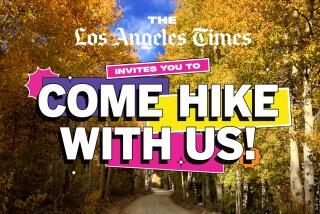A cyclist hits pay dirt
Until this month, my last off-road biking experience was as a third-grader pedaling a mile to school on a secondhand red Schwinn. To get there, I took a shortcut -- a well-worn dirt path through the pines with only the occasional thick tree root in my way.
It hardly would qualify as mountain biking, a sport that now sends millions of people into the wilds each year. The activity skyrocketed in popularity during the late ‘80s and early ‘90s, earning a slot as an official Olympic event in 1996. Better and more affordable bike technology, an abundance of trails and just the right hint of the extreme-sports movement helped fuel its appeal.
But by the time mountain biking had become a full-fledged craze, I was committed to other fitness activities. As it turns out, that was my loss. Even a beginner’s outing can offer a thrilling and top-notch cardio workout, not to mention a rousing trip through nature.
Southern California boasts some of the country’s best mountain-biking trails, which, luckily for novices like me, can accommodate all skill levels. I knew the trails were there, but I wasn’t sure how to find them. I contacted the Pasadena Mountain Bike Club and found that it sponsors a beginner’s ride for prospective members twice a month.
I was all set -- except, of course, for equipment. This was the most problematic part of coordinating the trip. A new, top-of-the-line mountain bike can run into the thousands of dollars; even a solid used one can easily cost $500. Many bike shops don’t rent mountain bikes at all. Instead they usually offer a “demo,” a bike you try out for a day or two. Typically, the shop will deduct the demo cost, usually around $50, from the bike’s purchase price if you decide to buy one.
Rentals are a little tougher to find, but through the Pasadena club’s Web site (www.pmbc.org), I found one in nearby Altadena that charged $25 a day. The thick-tired bike with 24 gears had a set of shock absorbers in the front, part of the design improvement that has enabled more people to enjoy the sport.
That’s right. In the early days of the sport, born in the hills and valleys of Northern California in the 1970s, the pioneers took to rocky trails on bikes with no shock absorbers. Ouch. Today, you can get a bike with shocks on the front and rear.
The only other requirement for the club’s ride was a regular cycling helmet, which costs about $30. Scott Dayman, who has been leading the Pasadena club’s beginner rides for more than five years, says helmets are the cheapest insurance you can buy in mountain biking.
Maybe it was the recent heat wave, but I was the only person -- other than Dayman and his wife, Katrina -- who showed up the morning of the beginner’s ride at a Pasadena bike shop. By 8:30, temperatures were approaching 80 degrees.
The couple said the beginner rides usually attract two to six people.
We drove for a few miles to the Arroyo Seco, unloaded our bikes near the Jet Propulsion Laboratory and pedaled our way to the trail head in the Angeles National Forest. Walkers, joggers, mountain bikers and horses all share the 3 1/2-mile trail with good cheer and amiability. More often than not, trail users greet strangers with a hearty “good morning.”
We started out at a fairly brisk pace along the trail, which gradually climbed into the mountains. We halted a couple of times, as per trail etiquette, for horses. Horses can be spooked easily by mountain bikers, so we waited until the animals had passed before pedaling onward. Otherwise, the trail for the most part is wide enough to accommodate bikers and joggers without either having to halt. The brief respites provided a good opportunity to reach for the water bottles and stay hydrated.
The trail cut through a wooded area that offered plenty of shade and welcome relief from the morning heat. But even if it had been cooler, we still would have worked up a good sweat maneuvering around or over trees, branches, roots, rocks and shallow streams.
Part of the trick of navigating is knowing which gear to use to maximize speed and minimize effort. This took a lot of trial-and-error work for me, as rapid changes in terrain required frequent gear adjustments.
Another difficulty was pedaling over rocks, some as big as shoe boxes. At several points along the way, they were unavoidable, leaving me little choice but to plow -- or walk -- my bike over them. In the true spirit of mountain biking, I chose to plow, with mixed results. I was bouncing so hard down one steep incline that I pressed the brakes to better control the ride down. That just stopped me altogether. Katrina advised that it’s best to let it rip down the rocks.
After we had finished the beginner route, Scott and I started up the fire trails. The first ride was a decent workout and great fun, but I still had too much life left in my legs to call it a day. The steep, winding but smooth fire trails are cut through the mountains so firefighters can battle hillside blazes. They can be unrelenting and offer no shade.
After about 10 or 15 minutes, I relented. But not before I was soaked with sweat. We turned around and flew back down the hill -- a fitting, well-deserved ending to a lively workout.
*
(BEGIN TEXT OF INFOBOX)
Snapshot: Mountain biking
Duration of activity: 92 minutes
Calories burned: 1,241
Heart rate*: Average, 139; range, 88 to 173.
* This information was obtained using a heart-rate monitor.
*
Martin Miller can be reached at martin.miller@latimes.com.


